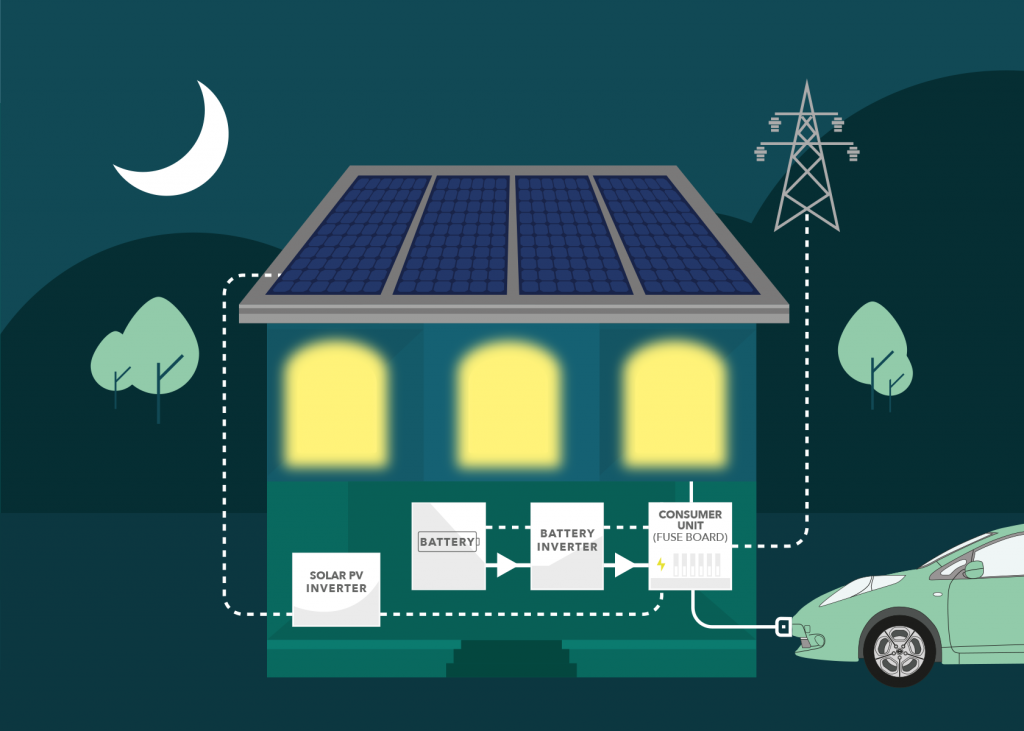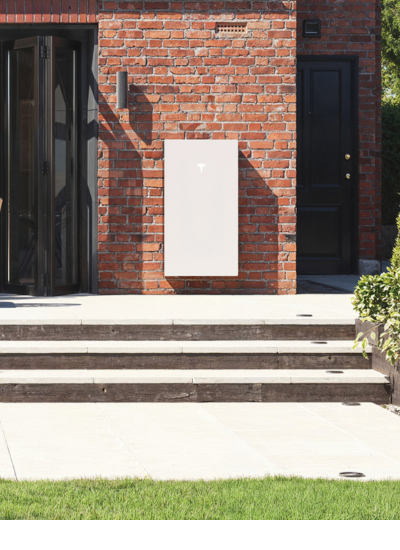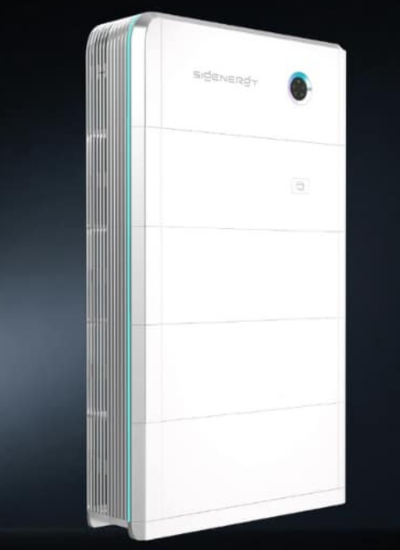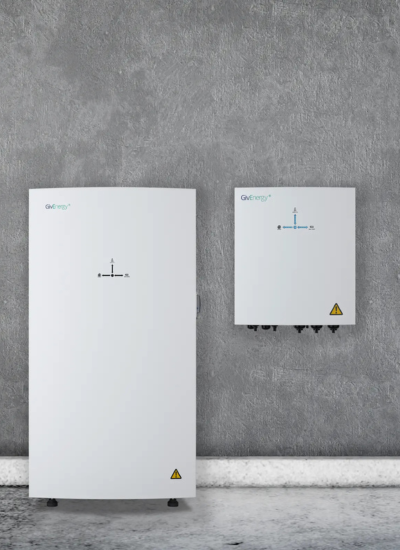Solar battery storage
A huge step towards energy independence: Solar Battery Storage lets you save up energy for the time you really need it and you can support the grid at peak times to further reduce your bills with Solar Grid Trading.
Adding Solar Battery Storage minimises your reliance on the grid, reduces the money you put in your energy supplier’s pocket and allows you to help the grid become more CO2e efficient. So what should you look out for when choosing a Solar Battery Storage solution? Here’s the 6 questions you need to ask before making a decision.
The 6 ‘Watts?’ of Solar Battery Storage
1. What’s ‘Useable Capacity’?
Battery capacity is the amount of energy in kWh (units), that a battery can store.
However, some Solar Battery Storage systems are misleadingly advertised quoting ‘Total Capacity’. Fully discharging any battery is damaging so there’s always a minimum charge state that is maintained. While some manufacturers advertise the Total Capacity, you may not be able to use all of it.
Look for the ‘Useable capacity’ figure, which may be buried in a datasheet or even stated as ‘Depth of Discharge’, which is usually measured as a percentage of the Total Capacity.
For example, Sigenergy’s SigenStor has an Advertised Capacity of 6kWh while it’s Useable Capcity is 5.8kWh.
2. What capacity do I need?
While your energy consumption and solar generation will have an influence, the most overlooked consideration is your own needs & desires. Naked Solar customers commonly consider one or all of the following that will all influence their decision about how much Solar Battery Storage capacity is right for them.
- Minimising bills
- Quickest payback
- Utilising Solar Grid Trading
- Powercut cover
- Planning an EV
Many Solar Battery Storage solutions are expandable, allowing you to increase your capacity in the future to match changing energy demands. This can be an appealing opportunity to ‘dip your toe’ however, some Solar Battery Storage manufacturers update their products and cease production of older expansion modules, so bear this in mind if you’re planning future expansion.
3. What’s covered by warranties?
Warranties can be a minefield in any industry and unfortunately, the Solar Battery Storage industry is no exception. There’s 3 elements to be aware of in Solar Battery Storage warranties.
- Product – Covers the intergrity and functionality of the physical unit itself. Labour may or may not be covered depending on the manufacturer.
- Warrantied Cycles – refers to the equivalant energy throughput of one full discharge, so you can multiply the Useable Capacity of the battery by the number of cycles warrantied to calculate how much energy it’s warrantied to deliver.
- Warrantied Capacity % – As battery capacity degrades over time, Warrantied Capacity is the minimum amount of energy storage capacity guaranteed to be remaining by the manafucturer within the warranty period.
It’s important to note, Warranties are valid for whichever gaurantee is reached first, e.g. for Sigenergy it’s 10 Years OR 3500 cycles.
4. What is forecasting/AI?
To maximise the benefits of your Solar Battery Storage system, many manufacturers include Forecasting or AI systems, enabling your battery to charge up on cheap rate electric if there isn’t going to be enough solar generated the following day to fill your battery and keep you going through evening peak rate periods.
The Forecasting or AI comes in to play to learn your consumption habits, link that with weather forecasts to predict how much to charge your Solar Battery during off-peak times, enabling you to minimise bills and maximise Solar Grid Trading opportunities without needing to manually invervene.
5. What about power cuts?
Not every Solar Battery storage system will continue to work when there’s a powercut. To add this capability, your Solar Battery Storage system will need to disconnect from the grid to protect any maintenance workers who are repairing the grid. This requires the addition of a grid isolation switch which most manufacturers now refer to as the ‘Gateway’. In the table below you’ll see we’ve listed the expected price for adding this capability. Not all Solar Battery Storage systems will allow your Solar to continue to work in a powercut, especially if your full house is not covered by the backup.
6. What’s the right one for me?
We hope that these explanations and the table below will help you to understand what to consider when choosing a Solar Battery Storage system. There’s a lot more manufacturers and options available to you than we can fit in the table so now that you have the questions you need to ask, go explore!
Of course Naked Solar’s Award-Winning team of expert Solar Consultants would love to help. They’re trained to be impartial and help you find the best solution for your needs, even if that solution is to not buy Solar Battery Storage.
Compare Solar Batteries
Use the table below to compare some of the battery systems available on the market. This information is for guidance only, it should be very close, so check with our friendly team at Naked Solar, or the manufacturer for latest info before making your final decision.
| Advertised Capacity (Min) | Useable Capacity (Min) | Installed Price from | Product Warranty | Warrantied Capacity | Warrantied Cycles | Weather Forecasting/AI | Expandable To | Full Home Power cut Cover | |
|---|---|---|---|---|---|---|---|---|---|
| Tesla Powerwall 3 | 13.5kWh | 13.5kWh | £8,921 | 10 yrs | 80% | Unlimited | Yes | 54kWh | + £568 |
| Sigenergy SigenStor | 6kWh | 5.8kWh | £6,697 | 10 yrs | 60% | 3500 | Yes | 52.6kWh | + £1,798 |
| GoodWe ESA All-In-One | 5.1kWh | 5kWh | TBD | 10 yrs | 80% | 6000 | Yes | 48kWh | Yes |
| Fox ESS - ECS Series, EP5, EP11, EVO, PowerQ | 5kWh | 4.66kWh | £5,655 | 12 yrs | 70% | 3375 | No | 37.7kWh | + £1,716 |
| Anker Solix X1 | 5kWh | 5kWh | £6,330 | 10 yrs | 80% | 2634 | No | 30kWh | No |
| EcoFlow Power Ocean | 5.1kWh | 4.8kWh | £6,120 | 15 yrs | 70% | 6000 | Yes | 15.5kWh | + £1,678 |
| SolarWatt (BMW) Vision | 5.8kWh | 5.2kWh | £6,535 | 10 yrs | 70% | 4273 | Yes | 18.2kWh | No |
| GivEnergy – AIO, Giv-Bat | 5.2kWh | 4.8kWh | £6,346 | 12 yrs | 70% | Unlimited | No | 28.5kWh | + £1,600 |
| Enphase IQ Battery | 5kWh | 5kWh | £3,715 | 15 yrs | 70% | 6000 | No | 5kWh | No |
How Solar Batteries Help You Night & Day


People often ask ‘Can solar panels work at night?’ The short answer is no. But with a solar battery, in effect they do.
During the day, when solar panels are generating more power than your property is using, excess power is diverted to the solar battery for use later. When the sun goes down, or if you’re using more energy than your panels are providing, the solar battery will kick in to give you power and prevent drawing from the grid.
Modern Time-of-Day (ToD) tariffs maximise your savings by treating your battery as a trading asset. Your system automatically charges on cheap overnight rates (2 am-5 am) and exports stored energy to the grid at the most profitable peak rates (4 pm-7 pm), maximising your return with Solar Grid Trading.
Dive Deeper Into Solar Battery Storage

TESLA POWERWALL 3
The Powerwall has transformed Solar for good. Tesla Powerwall 3 brings groundbreaking advancements that set a new benchmark for Solar Battery Storage systems, including unrivalled power output and exceptional flexibility to meet the needs of any Solar project.

SIGENERGY SIGENSTOR
SigenStor is an all-in-one smart energy solution designed to supercharge your home’s solar system. This single, sleek unit combines everything you need: a solar inverter, EV DC charger, battery pack, power conversion system, and energy management system.
Powered by AI, the SigenStor is a highly integrated and intelligent system that optimizes your home’s energy usage, making it an excellent choice for any homeowner seeking to upgrade their solar power.

GIVENERGY ALL IN ONE
GivEnergy is a British Owned Battery Storage Manufacturer with manufacturing/Research and Development facilities in the UK, Ireland, Australia and Shenzhen China (Shenzhen Givenergy Technology Co., Ltd). Their “All In One” Home Battery can power even the highest-demand households with maximum efficiency and minimum energy costs, making them a Tesla Powerwall alternative UK residents love.